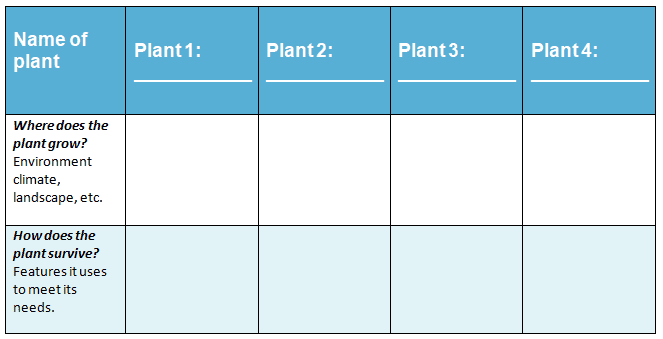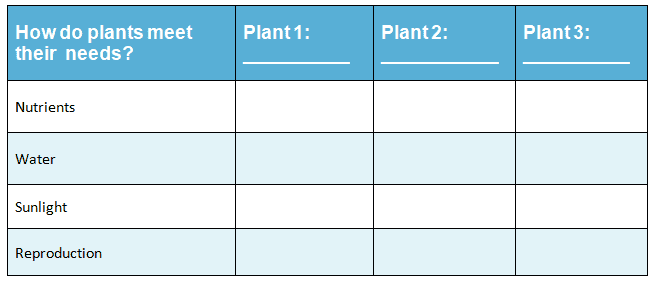Information for Teachers
Curriculum links
This investigation is linked to the following Grade 5 Next Generation Science Standards.
PS3.D Energy in Chemical Processes and Everyday Life
The energy released [from] food was once energy from the sun that was captured by plants in the chemical process that forms plant matter (from air and water). (5-PS3-1)
LS1.C Organization for Matter and Energy Flow in Organisms
Food provides animals with the materials they need for body repair and growth and the energy they need to maintain body warmth and for motion.
Plants acquire their material for growth chiefly from air and water. (S-LS1-1)
LS2.A Interdependent Relationships in Ecosystems
The food of almost any kind of animal can be traced back to plants. Organisms are related in food webs in which some animals eat plants for food and other animals eat the animals that eat plants. Some organisms, such as fungi and bacteria, break down dead organisms (both plants or plants parks and animals) and therefore operate as “decomposers.” Decomposition eventually restores (recycles) some materials back to the soil. Organisms can survive only in environments in which their particular needs are met. A healthy ecosystem is one in which multiple species of different types are each able to meet their needs in a relatively stable web of life. Newly introduced species can damage the balance of an ecosystem. (5-LS2-1)
LS2.B Cycles of Matter and Energy Transfer in Ecosystems
Matter cycles between the air and soil and among plants, animals, and microbes as these organisms live and die. Organisms obtain gases, and water, from the environment, and release waste matter (gas, liquid, or solid) back into the environment. (5-SL2-1)
How to search the internet
1 Keep your request short
Fewer words will give a more accurate search.
2 Choose exactly what you want
For example: Arctic Circle Climate
3 Use quotes
Double quotes around a set of words tell the search engine to consider those exact words in that exact order without any change. For example: “Arctic Circle Climate”
4 Use the plus sign (+)
If you add a plus sign (+) between words, the internet will search for all the words. For example: migrate+birds+whales+mammal
5 Use the minus sign (–) to say what you don’t want
Use a minus sign (–) to show words you do not want to appear in your results. For example: if you search for burrowing animals and do not want mammals in your search, –mammals will exclude mammals. Note that you need to put a space before the minus sign for the word to be excluded.
6 Be very clear about what you don’t want
Part 1
Ask questions and define problems
After reading How Do Plants Survive? you may have many questions about the amazing world of plants.
List your questions.
- Compare your list with questions that others have.
- Choose a question you would like to investigate.
- You can work alone, with a partner, or in a small group.
You may want to choose one or more of these questions to investigate
Q1. What other plants get their nutrients by ingesting animals?
Q2. What other plants can survive in extreme climates such as deserts?
Q3. What plants grow in water? How do these plants survive?
Q4. What features help plants to survive in various types of environments?
Go to Part 2 Investigate →Part 2
Investigate
Helpful websites
You may want to use websites to help with your investigations.
You can use words like these in doing your search:
Animals+nature+plants
Succulent+adaptation
Carniverous+plants
photosynthesis, pollination, plant reproduction, etc.
You may want to learn more about plants that live in a particular environment, e.g. rainforest plants or desert plants. Or do a search about plant survival in these places by using the name of the habitat, e.g. plant+survival+rainforests, plant+survival+deserts, plant+survival+tundra
Go to Part 3 Record data →Part 3
Record data
Find ways of recording your information that will allow you to see any patterns in the data.
Data Chart for plant survival and adaptations
(Download and change to suit your information)
 Download Chart
Download Chart
Go to Part 4 Organize, analyze, and interpret data →
Part 4
Organize, analyze, and interpret data
1. Look over the information you have gathered and the patterns you have found.
What do most plants have in common?
What differences have you discovered between the plants you have investigated?
How do the plants you investigated meet their needs: nutrients, water, sunlight, etc.
2. Search for other patterns.
What adaptations have the plants you investigated developed to survive in the environments where they live?
How do the features of plants reflect the environments they grow in?
3. Makes notes about what you find.
Go to Part 5 Present and share →Part 5
Present and share
Look over all of the information that you have gathered in your investigation.
What are the most important ideas about how plants survive?
Make a chart showing the most important ideas.
 Download Chart
Download Chart
← Return to menu